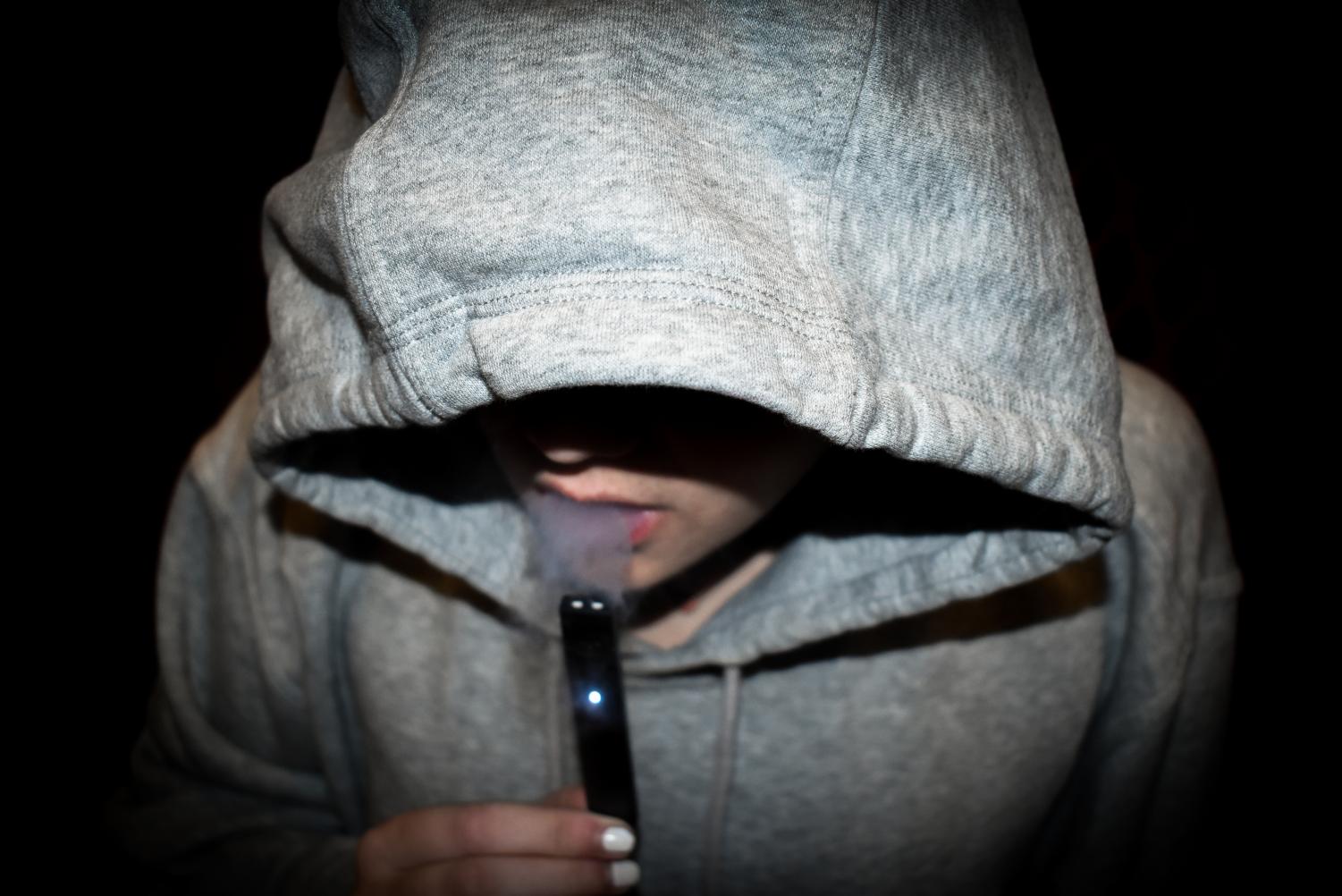34 percent of Algonquin students admitted that they have vaped, according to a Harbinger survey conducted from December 4 to December 10 through Google Forms. E-cigarette usage across the country has spiked among adolescents in recent years, leaving students, parents and faculty wondering if the outbreak is a fad, or if it is here to stay.
“It’s like eating a nice, warm piece of pie, or something that’s nice and warm,” said Carmen*, an Algonquin senior, as she described the sensation that vaping provides. “It’s comforting almost.”
It all started on the last day of her sophomore year: Carmen attended a sleepover with her closest friends, and a boyfriend was there with his vape.
“We all just took a hit,” Carmen said.
Carmen “didn’t really think too much of it” the first time she vaped. It was simply fun and enjoyable, and definitely something she wanted to try again.
“I thought it was cool and interesting,” Carmen said. “I tried to do some tricks [such as blowing rings]. At first everyone coughs and chokes on it, but I thought it was fun.”
Carmen is one of the 34 percent of Algonquin students who have vaped, according to the Harbinger survey. Of those who vape, 17 percent began vaping before freshman year.
Often employing devices such as a JUUL or Phix, users inhale and exhale vapor which, according to the U.S. Surgeon General, contains nicotine, ultrafine particles, diacetyl (a chemical that has been linked to cancer), heavy metals and organic compounds.
Since her first time vaping, Carmen often vapes by herself while driving. As someone who was diagnosed with Attention Deficit Disorder and cannot focus on one thing, she resorts to pulling out her Phix, a vaping device she purchased for 40 dollars at Vape City in Westborough. Vaping is “just something to do” during her mundane daily routine to relieve boredom.
Carmen vapes in social settings as well. According to the Harbinger survey, 73 percent of vape users vape at parties, 80 percent vape with close friends and 44 percent vape alone.
“In social situations, people definitely [feel pressured] because literally everyone is doing it,” Carmen said.
Albert,* a senior whose friend purchased a Suorin Air vape for him at Vape City in November, uses vaping as his vice to relieve stress build-up. According to the Harbinger survey, 24 percent of students who vape own their own vaping device. Albert originally was opposed to vaping, but that all changed one day in class. Since “a bunch of kids were just going around hitting it,” Albert decided to join in.
Albert now vapes about ten times a day, on days when he does not purposely leave his vape at home to prevent becoming addicted to nicotine.
“I personally have had some events in my life that have caused a lot of stress, and it just helps get your mind off of things and relax you,” Albert said.
Since the first time, vaping has allowed him to divert his attention from causes of stress in his daily life.
“The more stuff you see about how nasty humanity can get, the more sane that this stuff seems,” Albert said. “Because of certain events that have happened to me, I was just looking for absolutely anything to help relieve the stress, but I did not want to get into hardcore stuff.”
For Albert, vaping provides a certain “sensation of the brain” that he cannot find from doing anything else. Other vape users agree.
“This is going to get weird, but it’s a headrush that’s almost orgasmic, but it’s all in the head,” Albert said. “I have noticed that if I am taking in a lot, the headrush is bigger. I’ve noticed that sometimes colors can get vibrant, but it’s not necessarily an ‘under the influence’ feeling where my reactions are slow.”
“It feels good if you vape a lot really quickly,” Carmen said. “It’s called getting ‘nicked’ out because it’s nicotine. It’s a little headrush, so it’s just a quick and easier way to get a little buzzed without having to smoke or drink or do anything major.”
Dangers
According to the Centers for Disease Control and Prevention, scientists do not know all health effects associated with nicotine vapes, since they are fairly new products, but they do know that nicotine can harm brain development in adolescents.
On the national scale, vaping has increased in popularity in recent years. In 2015, more than 25 percent of students in grades six through twelve reported they had ever tried an e-cigarette, according to the U.S. Surgeon General.
Aside from causing still-developing teenage brains to become addicted to nicotine, the U.S. Surgeon General’s “Know the Risks of E-cigarettes for Young People” webpage states, “The nicotine in e-cigarettes and other tobacco products can also prime the adolescent brain for addiction to other drugs such as cocaine.”
“The biggest problem with vaping is kids are proud of it because it’s cool,” health teacher Melissa Arvanigian said. “Most kids that vape will lead into smoking weed because that’s the next progression. I think we’re going to continue having a gateway drug problem using the vaping device.”
According to Arvanigian, vaping could lead to a long term addiction.
Aside from vaping on her way to and from school, Carmen admits that she has vaped in a school bathroom on several occasions. Despite her daily habit, Carmen does not identify as a nicotine addict. In addition to vaping, she is interested in other addictive substances as well. As someone fascinated by the power that drugs possess, she admits to using alcohol and marijuana.
“I’m not really opposed to trying things when it comes to drugs or alcohol or other substances,” Carmen said. “It’s not something that really scares me; I just see [drugs] as a tool.”
However, Carmen recognizes that “vaping is nicotine and nicotine is an addictive drug, so it can be addictive.”
Though she believes vaping is bad for her lungs, she doesn’t consider it to be as bad as a cigarette or marijuana joint. Carmen inserts a pod, which lasts for about 400 puffs, into her Phix about once every week or two. According to the Phix sales webpage, the nicotine in one Phix pod is equal to two packs of cigarettes.
Arvanigian blames the lack of knowledge about the dangers of vaping on the marketing of the product.
According to a 2016 BMJ Journal study, research shows that the flavors appeal to teenagers. Flavors include mint, tobacco, butterscotch and many fruit flavors. 85 percent of vape users ages 12 to 17 use flavored pods, according to the U.S. Surgeon General.
“I think the lack of information and education all around is not only where the generation gap comes in but I think it also is for students as well thinking they’re doing something harmless,” Arvanigian said. “The tobacco companies have promoted and advertised [vaping] as a safe version [of smoking cigarettes].”
According to the Harbinger survey, 32 percent of those who vape do so every day, but Carmen believes nicotine addiction has gone unnoticed in the community.
“I think [vaping] definitely starts out as something that is cool, and if you develop an addiction within that, I think we are too young to have noticed because we are still in that honeymoon phase,” Carmen said.
Principal Dr. Sara Pragluski Walsh advises students to seek help from a trusted adult if they feel stuck in a situation that could lead to an addiction.
“I would recommend if kids are really stuck or really jammed up or really feel like they’re addicted, see their guidance counselor, see the nurse,” Walsh said. “High school is where you make some of those mistakes that we can either learn from for the rest of our lives or that can hold us back for the rest of our lives, and I’d rather empower you now in that positive choice versus have you look back 20 years from now and regret.”
Walsh believes that the use of vaping at Algonquin could be caused by students feeling disconnected from the school community.
“Is it that you don’t feel like you have a strong connection with an educator? Is that why you had to turn to vaping? Let’s figure it out,” Walsh said. “Is it you feel like you don’t belong to a club or organization? Because some of [those who vape] don’t and that’s how they fill their time. Great, let’s figure out your niche.”
“Is it because at home you don’t feel safe, whether it’s your current neighborhood or who lives at your home?” Walsh continued. “Great, let’s figure that out. Let’s tackle each one at a time and then if at the end you still feel like you need to vape, after you’ve been educated on what vaping does to you, you’ve got all of your assets and attributes set up, then at that point we’ve done the best that we can do.”
Walsh knows that nicotine addiction is a serious issue that must be met with offerings of help, not only discipline, in order to help students in need.
“For anybody with an addiction, me standing there yelling for them to stop does not empower them to stop; that does not work,” Walsh said. “I have to provide them the skills and that is the best I can do because I know they don’t want to come see me. I can provide them with the information and skills to make sure they have every possible resource in their life to be successful.”
Administration Efforts
This year, the new administration has tried to be more proactive in stopping vaping occurrences on school property. For them, this means being more “prevalent” or having an increased presence around the school, according to Walsh. From administration members more frequently roaming the hallways to having more faculty around the bathrooms, Walsh strives to “alleviate the concern of safety.”
“[We’re] more prevalent in the hallways, more prevalent through having more adults around the bathrooms, more presence in the cafeteria so that if a student has a concern there’s somebody nearby, there’s somebody that they can turn to,” Walsh said. “And that’s why I think you see the assistant principals more often than last year in the hallways.”
According to Walsh, there is no recorded frequency of how many students have been caught vaping in school this year. First-time offenders are often disciplined with an in-school suspension, but the administration believes in “progressive discipline” for repeated offenders.
However, the administration’s efforts to combat vaping have been met with criticism by a number of students.
“Smoking in the bathroom has been a thing since the greasers in the 1950’s,” Carmen said. “It’s one of those problems where it’s like, ‘I don’t know what magical thing you are trying to come up with to cure this century-long problem.’ I don’t think [the administration] cracked any codes that other people haven’t.”
Some interviewed and surveyed students report that they have vaped or witnessed others vaping not only in bathrooms, but in classrooms.
The discrete design of many vaping devices makes it difficult to detect classroom or bathroom usage. Popular brands, such as Phix and JUUL, make products that resemble flash drives rather than smoking apparatuses.
“You can disguise it a lot better [than a cigarette],” Arvanigian said. “They’re making vaping devices look like USBs, pens or credit card holders.”
“It is very discrete,” Albert said, describing his Suorin Air vape. “It kind of looks like a credit card, except it’s a bit thicker. You just hit it out of one of the corners when you turn it on, and it does not produce as thick of clouds as expensive vapes do, so it’s easier to get rid of the smoke.”
Out of the 41 percent of Algonquin vape users who identified in the survey that they vape during school, some feel that the administration is taking the necessary steps, given how widespread the problem is.
“I do think it’s good that they are putting restrictions on it, and people overreact when they do stuff about it because you can’t do something that’s not allowed…” Albert said. “You’re the one that got [yourself] into that situation.”
A senior vape user named Ellie*, who owns both a Phix and a JUUL, understands the administration’s efforts to prevent in-school vaping.
“I guess [the administration’s procedures to combat vaping] are right because it’s illegal, since most of us are underage,” Ellie said.
The Generation Gap
For past generations, cigarettes were as mainstream as owning a vape today. Since the rise of vaping, a generation gap between teenagers and their parents has become evident.
Arvanigian has witnessed the generation gap, and wants to empower parents with information about the dangers of vaping.
Arvanigian is creating a new program for parents to educate them about different vaping devices and vape shops, as well as associated risks of vaping. She believes enacting such a program will help bridge understanding.
“I think the generation gap is that parents don’t think their student or child is doing it,” Arvanigian said. “They think everyone else is doing it. Because back in the day when the parents were younger, if they were experimenting in all that, you could smell the smoke on the person because it was smoke.”
Other parents may look the other way because they believe vaping is relatively harmless.
“My parents know I do it, and they’re honestly fine with it because they think it’s better than me smoking weed,” Ellie said.
Carmen’s parents are aware that she smokes marijuana and drinks alcohol, but she keeps her vaping hobby a secret.
“I feel like that would be the last thing [my parents] want me to do,” Carmen said. “The reason people smoke pot is to get high, and the reason people drink alcohol is to get drunk. The reason people vape: there’s no good one.”
Jack* is a sophomore who does not own his own vape, but vapes about two times a week by borrowing vapes from friends. He understands the difficulty in parents detecting if their child vapes.
“If you want to catch your kid, catch up with the slang terms and check if your kid is being suspicious or overprotective of their belongings,” Jack said.
The administration has been hosting informational events for parents to combat adolescent usage of dangerous substances. On November 8, the school hosted a showing of the short film “If Only” that illustrated the effects of opioid abuse.
Walsh encourages parents to have an open dialogue with their children about the dangers of vaping and other illegal substances.
“Even though I could educate every parent on what vaping is, by the time I did that, we would be on to our next [fad],” Walsh said. “So all I can do is empower parents about having the conversations with their children and following up in those engaging, relationship-building conversations.”
The Future
Even though she is skeptical that vaping will remain popular in the long run, Carmen believes that vaping “makes you feel cool,” which encourages its spike in popularity.
“Vaping is a fad, and with any fad, like fashion or anything, there’s always a draw to do it because you think if you do something that’s popular you’ll be liked,” Carmen said. “Who doesn’t want to be liked?”
Carmen believes that “Pot and alcohol will be around forever and people will always use them,” but does not blame the popularity of vaping on accessibility. She feels that marijuana is easier to obtain, and will remain after the vaping trend fades.
“Marijuana, in accessibility, cannot be used in the same sentence [as vaping] when describing Algonquin,” Carmen said. “Marijuana you can get anywhere, especially as a senior. I know where I could get marijuana at this exact moment. I don’t think [vaping’s popularity] has anything to do with the accessibility because it is kind of a chore to get a vape, especially if you’re a lowerclassman.”
Carmen is concerned that future generations will have moved on from vaping to a more dangerous activity by the time they reach high school age.
“I think every generation grows up a little faster, so will [vaping] be such a thing when [freshmen] become seniors?” Carmen said. “Maybe not, because they did it in eighth grade and got over it fast. Maybe they’ll be onto God-knows-what.”
Arvanigian believes that vaping is here to stay for younger generations to come.
“Unfortunately, I think it’s a long-term issue,” Arvanigian said. “I don’t think it’s a fad. The reason is, it’s cool to vape. It’s cool to have that device.”
“Not to diss our generation, but I think we just have a lot of simple-minded people who do stuff just to do it because a lot of people are doing it,” Albert said.
*Names of students have been changed to maintain anonymity.




